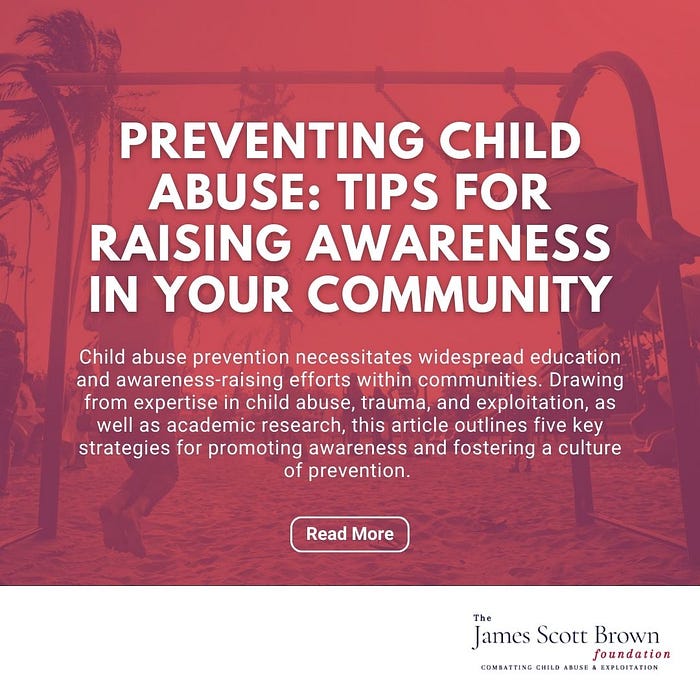Preventing Child Abuse: Tips for Raising Awareness in Your Community by James Scott Brown Foundation
by James Scott Brown Foundation

Abstract:
Child abuse prevention necessitates widespread education and awareness-raising efforts within communities. Drawing from expertise in child abuse, trauma, and exploitation, as well as academic research, this article outlines five key strategies for promoting awareness and fostering a culture of prevention. By engaging in proactive measures and facilitating community-wide involvement, individuals can contribute to the protection of vulnerable children.
- Organize Educational Workshops and Seminars:
Host workshops and seminars that address the topic of child abuse prevention, inviting experts to share their knowledge and experiences. These events can foster understanding and equip community members with skills and strategies to identify and prevent child abuse (Wurtele, 2009).
2. Develop and Distribute Informative Materials:
Create and disseminate educational materials, such as pamphlets, posters, and online resources, that raise awareness of child abuse and provide information on prevention and reporting. These resources can serve as a valuable tool in promoting vigilance and facilitating community-wide engagement (Kenny, 2004).
3. Collaborate with Local Organizations:
Partner with local organizations, including schools, religious institutions, and social service agencies, to integrate child abuse prevention efforts into existing programs and initiatives. Collaborative approaches can expand the reach of prevention efforts and foster a collective sense of responsibility for child protection (Finkelhor, 1994).
4. Promote Reporting and Support Services:
Raise awareness of existing reporting mechanisms and support services, ensuring that community members know how to access help if they suspect abuse. Encouraging timely reporting and intervention can significantly improve outcomes for affected children (Gilbert et al., 2009).
5. Advocate for Policy Change:
Engage in advocacy efforts at local and national levels, promoting the adoption of evidence-based policies and programs that effectively prevent child abuse. Supporting comprehensive policy reform can lead to long-lasting, systemic improvements in child protection (Chaffin et al., 2011).
Conclusion:
Raising awareness and fostering a culture of prevention are critical components in the effort to eradicate child abuse. By implementing the strategies delineated above, individuals can help promote vigilance, education, and community-wide engagement in protecting vulnerable children.
References:
Chaffin, M., Friedrich, B., Kelleher, K., & Shelley, G. (2011). Looking to the future of child abuse and neglect prevention in the United States. Child Abuse & Neglect, 35(12), 1066–1074.
Finkelhor, D. (1994). The future of children’s advocacy centers: Beyond the multidisciplinary response to child abuse. Child Maltreatment, 17(2), 86–95.
Gilbert, R., Widom, C. S., Browne, K., Fergusson, D., Webb, E., & Janson, S. (2009). Burden and consequences of child maltreatment in high-income countries. The Lancet, 373(9657), 68–81.
Kenny, M. C. (2004). Teachers’ attitudes toward and knowledge of child maltreatment. Child Abuse & Neglect, 28(12), 1311–1319.
Wurtele, S. K. (2009). Preventing sexual abuse of children in the twenty-first century: Preparing for challenges and opportunities. Journal of Child Sexual Abuse, 18(1), 1–18.
Read more at the James Scott Brown Foundation.
Comments
Post a Comment